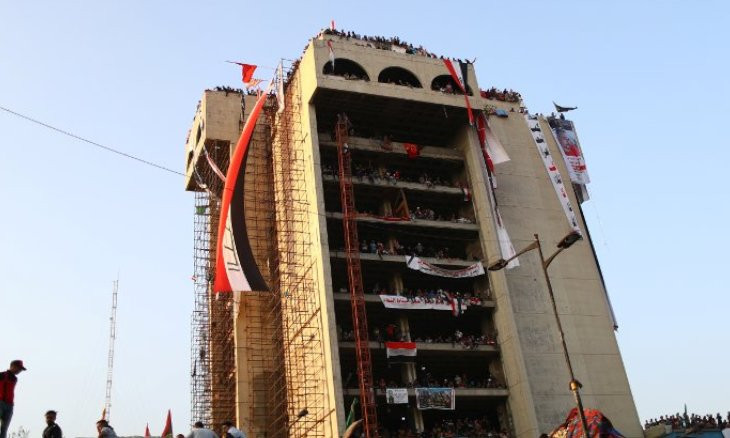Sadrists take control of Turkish Restaurant building occupied by protesters
Supporters of Moqtada al-Sadr took control of the Turkish Restaurant building, as the political leader urged his supporters known as "blue hats" on Feb. 2 to work with authorities to ensure schools and businesses can operate normally again. The Turkish Restaurant, a tall building occupied by demonstrators since October, was mostly empty after Sadrists drew out demonstrators and the blue hats stood guard outside it.
Duvar English/Reuters
Supporters of Iraqi Shia cleric and political leader Moqtada al-Sadr took control of the Turkish Restaurant building on Tahrir Square in Baghdad on Feb. 1, seizing the protest site from anti-government demonstrators.
Sadr, who has alternately sided with the anti-government protesters and the Iran-backed political groups they reject, urged his unarmed supporters known as "blue hats" on Feb. 2 to work with authorities to ensure schools and businesses can operate normally again.
He also called on his supporters to help security forces clear roads blocked during months of sit-in protests, urging "day-to-day life" to resume following the appointment of a new prime minister.
"I advise the security forces to stop anyone from cutting off roads and the ministry of education should punish those who obstruct regular working hours, be they students, teachers or others," Sadr said in a statement published on Twitter.
Some of his followers appeared to have helped already to clear out protest areas in the Tahrir Square overnight, a Reuters reporter said.
The Turkish Restaurant, a tall building occupied by demonstrators since October, was mostly empty after Sadrists drew out demonstrators and the blue hats stood guard with walkie-talkies outside it.
 Iraqi protesters claim 'Turkish Restaurant' as makeshift headquarters
Iraqi protesters claim 'Turkish Restaurant' as makeshift headquartersAn abandoned shopping mall, the building is referred to as the Turkish Restaurant among Iraqis as a restaurant occupied its top-floor during the 1980s. The 18-floor building was abandoned after being bombed during the Iraq War (2003-2011).
Anti-government protests continued nearby, with demonstrators directing their ire toward new Prime Minister Mohammed Tawfiq Allawi, who was named on Feb. 1 as part of a deal between Sadr and rival Iran-backed political groups.
Protesters demanding the removal of Iraq’s ruling elite and the creation of better jobs and services have regularly blocked main roads in Baghdad and southern Iraq since demonstrations erupted in October.
A political opportunist, Sadr has directed anti-government unrest in previous years but he has not been able to control this round of demonstrations and many protesters oppose him as much as the rest of the political class.
The appointment of Allawi resulted from a deal following two months of wrangling between Sadr and pro-Iran parties, sources close to outgoing premier Adel Abdul Mahdi said.
Abdul Mahdi resigned in November under pressure from the street protests.
Sadr’s supporters had previously bolstered the protesters and sometimes helped shield them from attacks by security forces and unidentified gunmen.
But they withdrew from the main sit-in camps at his request earlier this month and even attacked protesters in Tahrir Square, the main protest camp in the capital, hours before Allawi’s designation on Feb. 1.
Many protesters, including some of his own supporters who had joined demonstrations, accused him of abandoning their cause. Many of Sadr’s supporters hail from eastern Baghdad slums and share the same grievances as many Iraqis - no work opportunities, poor healthcare and education.
The unrest is Iraq’s biggest crisis for years. It has shattered nearly two years of calm that prevailed after the defeat of ISIS in 2017.
